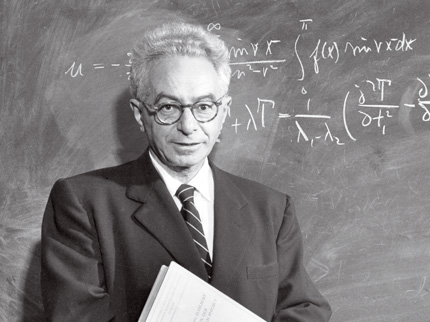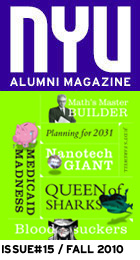Good with numbers, if not always with people, Richard Courant overcame war and anti-Semitism to build a towering math institute
by Amy Rosenberg
In 1934 Richard Courant, a Jewish professor and one of the most influential mathematicians of the 20th century, fled Germany with his wife and four children. Having been placed by the Nazis on “extended leave”—essentially, dismissal from his post at the University of Göttingen—he feared what might come next. He carried with him a letter offering a two-year faculty appointment at New York University, which some prominent American friends had helped to arrange. Grateful for the ticket out of his Nazi-ruled homeland, Courant nevertheless despaired to leave behind the university that had formed his career. He nearly lost courage altogether when a new colleague met the family at New York harbor and brought them to his home—an ancient, dilapidated railroad apartment in upper Manhattan—where a couple of Courant’s children would temporarily stay. In her biography of the mathematician, Constance Reid sums up Courant’s reaction: “The flat itself was…frightful, dreadful. Five rooms, kitchen and bath lay all in a row. Only one room had a real window, and it looked out on the street…Courant searched in vain for [a] study…Was this how a professor lived in New York?”
Anyone who knew Courant, however, also knew that he was an irrepressible optimist. Just a few weeks after his arrival, he met a friend from Germany who was familiar with the mathematician’s love of music (Courant had taught himself how to play the piano at the age of 14) and asked him whether he would be playing quartets again in his new home. Courant reportedly replied, “In this country not quartets. In this country, octets!” He had quickly absorbed the atmosphere of opportunity and gathered that it would be possible for him to accomplish much in this city.
He was right. Halfway through his two-year term, in 1935, Courant was asked to stay on at NYU and transform its nearly nonexistent math program—there was just one full-time faculty member at the time—into “a strong graduate department.” Eleven years later, having brought in research dollars by the bundle and assembled a world-class faculty, he became director of the university’s new Institute for Mathematics and Mechanics. Within a few decades U.S. News & World Report would rate it the best graduate department in the country in the field of applied mathematics, and it would become renowned worldwide for outstanding research in partial differential equations, probability, geometry, and computer science.
Today, on the 75th anniversary of its founding, the institute boasts 17 members of the National Academy of Sciences—more than any other mathematics department in the United States. In the past five years, three of its faculty members have won the Abel Prize, the field’s equivalent of the Nobel. Its reputation has grown over the decades, and it has changed along with the field of mathematics, but it has not forgotten its founder—a fact attested to by the name it received in 1964: the Courant Institute of Mathematical Sciences.
To many people, Courant probably seemed an unlikely candidate for transforming an insubstantial academic department into an internationally lauded center for study. He was a slight man, mumbly and contrarian, and he had what he himself called in a letter to a friend a “dangerous” propensity for making thoughtless utterances and an equally grievous tendency to “meddle” in others’ business. Some felt, too, that he was manipulative and so shrewd as to seem at times dishonest. “There were things about Courant which I found detestable….” admits James Stoker, who took over as director when Courant retired. “He was such a calculator.” But even Stoker balanced this criticism with praise for a man who was inarguably complex: “His merits were so great.… He was so helpful to people of all kinds…so willing to put himself out for people.”


Courant did have a reputation for extraordinary acts of generosity, often personally supporting penniless students or working tirelessly to find appointments for assistants and colleagues. He also had a talent for attracting support from people in positions of power. NYU professor Peter Lax, winner of the Abel in 2005 and a former director of the institute, knew Courant better than most. Lax even married the elder mathematician’s daughter after he had passed away. “He was not a conventionally dynamic person,” Lax notes. “But thoughtful people, influential people, and perceptive people realized that he was a person who could build things up. He was extremely smart, he was energetic, and he was a good judge of character.”
Just as important as these qualities, Courant had experience—he had already spearheaded the creation of the Mathematics Institute of the University of Göttingen, in central Germany. That university had attracted the world’s best mathematicians, from the early 19th century through to the reign of the Third Reich, but, until Courant came along, it had never had a center dedicated to advancing the field.
Courant arrived there in 1908, having excelled at his studies in gymnasium, the German equivalent of a college-prep high school, ready to work beside top-tier mathematicians. As a student at Göttingen, and later as a professor, he furthered fields related to applied mathematics, including numerical methods, calculus, and topology. In 1914, he was interrupted by a call for mandatory military service in World War I, and over the next four years he worked his way up to lieutenant in the 91st regiment, and survived a life-threatening injury. Even during the course of trench warfare near Reims, France, math was never far from his mind. One night in a foxhole, Courant realized that soldiers needed a method of communicating that could resist artillery fire. He landed upon a solution: earth telegraphy, or the production of electromagnetic signals using the ground as a conduit. After some collaboration, he and his colleagues in Göttingen developed a device he called a “magic box,” an apparatus that could transmit messages over two kilometers, which changed the nature of frontline battle.
 As soon as the war ended in 1918, he went right back to work, publishing several influential papers, most of them to do with Dirichlet’s principle (which, in a nutshell, concerns the use of a simple equation to solve a more complex one), and he co-authored Methods of Mathematical Physics, which became a seminal textbook for mathematicians and physicists. (Much later, in 1941, he co-authored What Is Mathematics?, another book that became, and is still considered, a seminal text for non-mathematicians interested in the field.) But the greatest mark he left on Göttingen was the Mathematics Institute he created. Courant pushed for the construction of a new building to house the mathematics department and the money he obtained included funding for an administrative support staff that had never really existed before. There was also a big push to create an institute that would allow for greater interaction between math and other scientific fields. Thus, unlike the centuries-old department that preceded it, the institute was a fundable, authoritative, dynamic center that kept the math curriculum at Göttingen moving forward.
As soon as the war ended in 1918, he went right back to work, publishing several influential papers, most of them to do with Dirichlet’s principle (which, in a nutshell, concerns the use of a simple equation to solve a more complex one), and he co-authored Methods of Mathematical Physics, which became a seminal textbook for mathematicians and physicists. (Much later, in 1941, he co-authored What Is Mathematics?, another book that became, and is still considered, a seminal text for non-mathematicians interested in the field.) But the greatest mark he left on Göttingen was the Mathematics Institute he created. Courant pushed for the construction of a new building to house the mathematics department and the money he obtained included funding for an administrative support staff that had never really existed before. There was also a big push to create an institute that would allow for greater interaction between math and other scientific fields. Thus, unlike the centuries-old department that preceded it, the institute was a fundable, authoritative, dynamic center that kept the math curriculum at Göttingen moving forward.
By the time Courant reached NYU, he had a sense of what was required to produce a top graduate program, and the political climate worked in his favor. The U.S. government was rapidly funding programs with a focus on applied mathematics and physics in order to further research that might aid the war effort. (The Manhattan Project was happening in a different part of the city around the same time.) Courant went after the research dollars and, Lax points out, he was savvy enough to realize that the government would continue these investments even after the war. Though he did not necessarily foresee the Cold War, he understood that the need to develop greater technology would continue to be a driving force for the new American superpower.
Another condition that helped Courant quickly advance the institute was the anti-Semitism from which he had expected to find escape when he left Europe. He was surprised, when he arrived, to discover that Jews faced discrimination in the United States, too. They were often excluded from the faculty of top-tier universities such as Harvard, Yale, and Columbia. Courant began to recognize New York as “a great reservoir of talent” and his department inadvertently benefited from academia’s anti-Semitism, welcoming Jewish scholars who had been shunned elsewhere, many of whom went on to become leaders in the field. Moreover, he used what he called “the Jewish angle” to raise funds for the department, appealing to successful Jewish businessmen and émigrés in the hopes that they would be eager to help support their brethren.
By the time he retired in 1958, Courant had, like other individuals born at the end of the 19th century, found his life shaped largely by the two World Wars. From his distinguished military service in WWI to the horrors of WWII, which had permanently uprooted his life, Courant always kept grounded by focusing on his one great passion. He lived for 14 years beyond his retirement, and during that time his mathematical activities never ceased: He updated his books, translated some of his early German works into English, and continued to lend his insights to the running of the Courant Institute.
While he worked, he began to see changes in the field of mathematics that worried him. The government still funded technological research, but the financial squeeze of the 1970s slowed down the influx of money, and with the waning of the Sputnik-inspired space race, the public’s focus was shifting. Also, within mathematics itself there was a movement away from applied practices and toward pure mathematics, a more theoretical realm with which Courant had never been comfortable. He felt the link between math and its practical applications was of paramount importance for the field. Nevertheless, with characteristic optimism, he told an interviewer toward the end of his life: “I think as long as the attitude with which science is pursued is honest and not dominated by commercialism, one must have confidence that something valuable will result.”
Courant recognized New York as “a great reservoir of talent” and his department inadvertently benefited from academia’s anti-Semitism, welcoming Jewish scholars who’d been shunned elsewhere.








